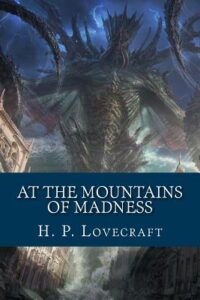The Concept of Limited Freedom on a Macro scale
Freedom and At The Mountains of Madness
By Kutay Kuzucu

H.P. Lovecraft’s novella (1931) At the Mountains of Madness explores the concept of limited freedom on a different scale, specifically within a world characterized by unequal power and advancement among countries. The book portrays a geologist named Dyer, who attempts to prevent an expedition to Antarctica. Through his retelling, we learn about a previous expedition that uncovered an ancient civilization and unearthed dangerous secrets hidden beyond a mountain range.
A smaller group, led by Professor Lake, is sent ahead and discovers remnants of prehistoric life forms. However, disaster strikes when they lose contact with the main group. Dyer investigates and finds the advance group’s camp in ruins, with most of its members dead and the better-preserved life forms missing. They come across the ancient civilization created by these specimens, depicted in murals that depict a struggle between the civilization and other ancient creatures. They also uncover the existence of an even greater threat lurking beyond.
Eventually, they manage to escape, but not before Dyer glimpses the unnamed greater threat and is driven temporarily insane. Dyer warns against further expeditions to Antarctica, highlighting how less advanced countries are restricted in their freedom compared to more advanced ones. The work raises intriguing questions about what would happen if an incomprehensibly advanced civilization came to Earth. In such a scenario, our ability to freely make choices would likely be constrained. This notion is not far from the truth in our own world.
For example, if a country possesses a valuable resource but lacks the technology or military strength to protect it, they are not free to utilize that resource as they see fit. African countries, despite having valuable resources like diamonds, often struggle to accumulate wealth. Furthermore, nuclear powers are limited and engage in agreements to prevent the proliferation of nuclear warheads while maintaining their own arsenals, known as their “deterrent.” This helps avert a devastating nuclear arms race, but it also perpetuates the power dynamics that favor those countries possessing such capabilities.
Knowledge is another valuable resource that remains limited to countries with superior technology and capabilities. Less advanced countries’ information agencies may not have the means to acquire valuable information from more advanced countries, while the latter likely possess extensive knowledge about the former without their knowledge. This power imbalance allows countries with greater technology and capabilities to curtail the freedom of other nations simply by virtue of their existence.
In conclusion, At the Mountains of Madness presents a perspective on limited freedom within a world characterized by unequal power and advancement among countries. The book prompts reflection on the potential constraints on freedom when faced with a vastly superior civilization. Similarly, in our own world, countries with advanced technology and capabilities possess the ability to limit the freedom of others. The work invites contemplation about the dynamics of power, knowledge, and resources, highlighting the complex nature of freedom in such contexts.

